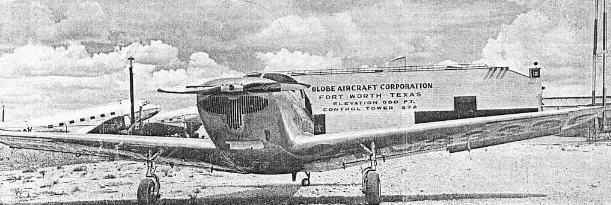 The birthplace of the Swift was Ft. Worth, TX, in early 1940. The very first low wing, two-place retractable gear aircraft called “The Swift” was built as what would be called today a “homebuilt,” by Mr. R.S. “Pop” Johnson of Ft. Worth. Mr. Johnson was reputed to have taken the trial delivery of a Culver Cadet, measured its vital organs and returned it to Culver, no purchase. Then he built himself an aircraft and began looking for a financier and builder. Mr. Johnson contacted Mr. John Kennedy of Ft. Worth. Mr. Kennedy was president and founder of Globe Medicine Company and Globe Aircraft Company. Known locally as a financier, entrepreneur and an all around good business man, Mr. Kennedy’s Globe Aircraft Company had been a very active sub-contractor during the war years, with production of Beech AT-10’s under contract for Beech and the war effort. Looking for postwar business, he and Mr. Johnson made a deal: Mr. Kennedy’s company, Globe Aircraft Company, would build the Swift and Mr. Johnson would be in the employ of Globe.
The birthplace of the Swift was Ft. Worth, TX, in early 1940. The very first low wing, two-place retractable gear aircraft called “The Swift” was built as what would be called today a “homebuilt,” by Mr. R.S. “Pop” Johnson of Ft. Worth. Mr. Johnson was reputed to have taken the trial delivery of a Culver Cadet, measured its vital organs and returned it to Culver, no purchase. Then he built himself an aircraft and began looking for a financier and builder. Mr. Johnson contacted Mr. John Kennedy of Ft. Worth. Mr. Kennedy was president and founder of Globe Medicine Company and Globe Aircraft Company. Known locally as a financier, entrepreneur and an all around good business man, Mr. Kennedy’s Globe Aircraft Company had been a very active sub-contractor during the war years, with production of Beech AT-10’s under contract for Beech and the war effort. Looking for postwar business, he and Mr. Johnson made a deal: Mr. Kennedy’s company, Globe Aircraft Company, would build the Swift and Mr. Johnson would be in the employ of Globe.
With Johnson’s “homebuilt” Swift as a starting point, Globe had Johnson working with their Chief Engineer K.H. “Bud” Knox in preparing the Swift for production. 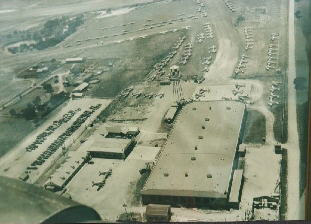 The war effort delayed their work somewhat but after going through 2 additional prototypes of all-wood or wood-metal construction, what finally emerged as the war was drawing to a close was an all metal version. While Kennedy was the driving force that brought about the Globe Aircraft Co. and production of the Swift, he himself gave credit for the design of the all metal version to Chief Engineer Mr. K. H. “Bud” Knox who was then a young design engineer for Globe Aircraft Company. As for Mr. Johnson, he became disenchanted with some of the changes occurring to “his” design and quit the company. (After leaving Globe Aircraft Co., he went back to Fort Worth and continued on his own. He then built the “Texas Bullet” and the “Johnson Rocket,” a few of which are still in existence today.)
The war effort delayed their work somewhat but after going through 2 additional prototypes of all-wood or wood-metal construction, what finally emerged as the war was drawing to a close was an all metal version. While Kennedy was the driving force that brought about the Globe Aircraft Co. and production of the Swift, he himself gave credit for the design of the all metal version to Chief Engineer Mr. K. H. “Bud” Knox who was then a young design engineer for Globe Aircraft Company. As for Mr. Johnson, he became disenchanted with some of the changes occurring to “his” design and quit the company. (After leaving Globe Aircraft Co., he went back to Fort Worth and continued on his own. He then built the “Texas Bullet” and the “Johnson Rocket,” a few of which are still in existence today.)
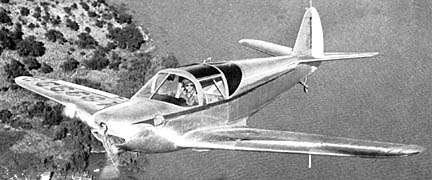 Logically promoted in period advertising as the ALL METAL SWIFT, to set it apart from the early prototype wood/tube/fabric Swifts, this was the start of the Swift as we know it today. The first, N33336, GC-lA s/n 2, is still in airworthy condition today. N33336 was the Swift used for all GC-1A flight tests, certification, etc. It was built and flight tested along with several other GC-lA’s in late 1945. Certification and the issuance of the Type Certificate A-766 for the 85 HP GC-1A was issued May 7, 1946. Beginning with s/n 2 and ending with s/n 409 a total of 408 GC-lA Swifts were built.
Logically promoted in period advertising as the ALL METAL SWIFT, to set it apart from the early prototype wood/tube/fabric Swifts, this was the start of the Swift as we know it today. The first, N33336, GC-lA s/n 2, is still in airworthy condition today. N33336 was the Swift used for all GC-1A flight tests, certification, etc. It was built and flight tested along with several other GC-lA’s in late 1945. Certification and the issuance of the Type Certificate A-766 for the 85 HP GC-1A was issued May 7, 1946. Beginning with s/n 2 and ending with s/n 409 a total of 408 GC-lA Swifts were built.
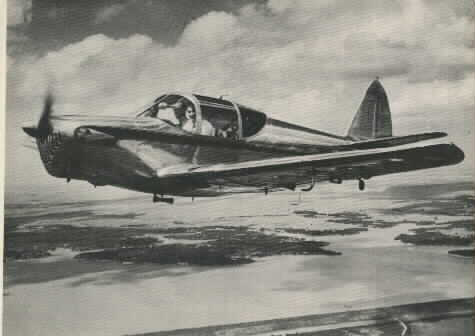 With the performance of the early Swifts showing 85 HP was just not doing the job, Globe worked to improve their aircraft. The Type Certificate for the 125 HP GC-1B was issued Sept. 22,1946. Production records show many of the flight tests of the early GC-lB’s also conducted early in 1946. Due to the success of the 1944, 1945, and 1946 national advertising programs, a tremendous demand and backlog of orders for Swifts resulted. All the ads of this period depicted the original GC-1 Swift. To meet this backlog of orders, Globe entered into a contract with newly founded TEMCO (Texas Engineering and Manufacturing Company) at nearby Grand Prairie, TX, to build Swifts under sub-contract simultaneously with the Globe production. Beginning in May of 1946, TEMCO set up production and began producing GC-1B Swifts at the rate of 15 aircraft per day. Temco built 329 Swifts. With globe and TEMCO together producing a Total of 833 GC-1B’s in just over s six-month period. All the effort was for not, however, as production finally caught up with orders and suddenly the parking fields near both plants were full of unsold Swifts. Kennedy soon closed the doors for various business reasons but primarily to avoid what we would today call a corporate “hostile takeover”.
With the performance of the early Swifts showing 85 HP was just not doing the job, Globe worked to improve their aircraft. The Type Certificate for the 125 HP GC-1B was issued Sept. 22,1946. Production records show many of the flight tests of the early GC-lB’s also conducted early in 1946. Due to the success of the 1944, 1945, and 1946 national advertising programs, a tremendous demand and backlog of orders for Swifts resulted. All the ads of this period depicted the original GC-1 Swift. To meet this backlog of orders, Globe entered into a contract with newly founded TEMCO (Texas Engineering and Manufacturing Company) at nearby Grand Prairie, TX, to build Swifts under sub-contract simultaneously with the Globe production. Beginning in May of 1946, TEMCO set up production and began producing GC-1B Swifts at the rate of 15 aircraft per day. Temco built 329 Swifts. With globe and TEMCO together producing a Total of 833 GC-1B’s in just over s six-month period. All the effort was for not, however, as production finally caught up with orders and suddenly the parking fields near both plants were full of unsold Swifts. Kennedy soon closed the doors for various business reasons but primarily to avoid what we would today call a corporate “hostile takeover”.
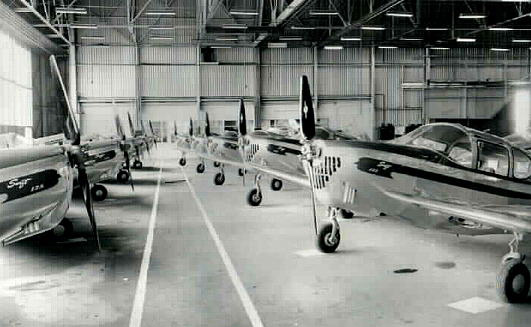 TEMCO obtained rights to the Swift as payment for money owned them by Globe. From 1947 through 1951, TEMCO produced 260 Swifts with the last one being rolled-out on August 23, 1951.
TEMCO obtained rights to the Swift as payment for money owned them by Globe. From 1947 through 1951, TEMCO produced 260 Swifts with the last one being rolled-out on August 23, 1951.
